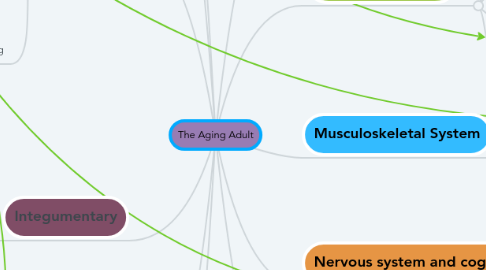
1. Cardiovascular Changes
1.1. Arterial walls thicken and stiffen, decrease in compliance.
1.1.1. Decreased cardiac reserve
1.2. Left ventricular and atrial hypertrophy. Sclerosis of atrial and metal valves.
1.2.1. Risk of isolated systolic hypertension; inflamed varicosities.
1.3. Strong arterial pulses, diminished peripheral pulses, cool extremities.
1.3.1. Risk of arrhythmia, postural and diuretic-induced hypotension
2. Pulmonary System
2.1. Decreased respiratory muscle strength; stiffer chest wall with reduced compliance.
2.1.1. Reduced pulmonary functional reserve.
2.2. Diminished ciliary& macrophage activity, drier mucus membranes. Decreased cough reflex.
2.2.1. Risk for decreased foreign matter clearance.
2.3. Decreased response to hypoxia and hypercapnia.
2.3.1. Increased risk of infection and bronchospasm with airway obstruction.
3. Renal
3.1. Decreases in kidney mass, blood flow, GFR (10% decrement/decade after 30). Decreased drug clearance.
3.1.1. Reduced renal functional reserve; risk of renal complications in illness.
3.2. Reduced bladder elasticity, muscle tone, capacity.
3.2.1. Increased risk of urinary urgency, incontinence (not a normal finding), urinary tract infections, nocturnal polyuria. Potential for falls.
3.3. Increased postvoid residual, nocturnal urine production.
3.4. In males, prostate enlargement with risk of BPH.
4. Oropharyngeal and Gastrointestinal
4.1. Decrease in strength of muscles of mastication, taste, and thirst perception.
4.1.1. Risk of chewing impairment, fluid/electrolyte imbalances, poor nutrition.
4.2. Decreased gastric motility with delayed emptying.
4.2.1. Altered drug absorption, increased risk of GERD, maldigestion, NSAID-induced.
4.3. Atrophy of protective mucosa.
4.4. Impaired sensation to defecate
4.4.1. Constipation not a normal finding. Risk of fecal incontinece with disease (not in healthy aging).
4.5. Reduced hepatic reserve. Decreased metabolism of drugs.
4.5.1. Stable liver function test. Risk of adverse drug reactions.
5. Musculoskeletal System
5.1. Sarcopenia with increased weakness and poor exercise tolerance.
5.1.1. Sarcopenia: Increased risk of disability, falls, unstable gait.
5.2. Lean body mass replaced by fat with redistribution of fat.
5.3. Bone loss in women and men after peak mass at 30 to 35 years.
5.3.1. Risk of osteopenia and osteoarthritis
5.4. Decreased ligament and tendon strength. Intervertebral disc degeneration. Articular cartilage erosion. Changes in stature with kyphosis, height reduction.
5.4.1. Limited ROM, joint instability, risk of osteoarthritis.
6. Nervous system and cognition
6.1. Decrease in neurons and neurotransmitters.
6.1.1. Impairments in general muscle strength; deep-tendon reflexes; nerve conduction velocity. Slowed motor skills and potential deficits in balance and coordination.
6.2. Modifications in cerebral dendrites, glial cells, synapses.
6.2.1. Slowed speed of cognitive processing. Some cognitive decline is common but not universal. Most memory functions are adequate doe normal life.
6.3. Compromised thermoregulation.
6.3.1. Decreased temperature sensitivity. Blunted or absent fever.
7. Sensory
7.1. Taste
7.1.1. Number of functioning taste buds decrease
7.1.1.1. Sweet and salty flavors
7.2. Vision
7.2.1. Reduced elasticity and stiffening of the muscle fibers of the lens
7.2.1.1. Decreased ability to focus
7.2.2. Reduced pupil size
7.2.3. Opacification of the lens and vitreous
7.2.3.1. Visual acuity declines
7.2.4. Difficulty seeing at night
7.3. Smell
7.3.1. Some olfactory function loss
7.4. Touch
7.4.1. Decreased tactile sensations
7.4.2. Difficulty discriminating between temperature
7.5. Hearing
7.5.1. Impacted cerumen
7.5.2. Sensorineural hearing loss
8. Integumentary
8.1. Flattening of the dermal- epidermal junction
8.2. Reduced thickness and vascular toy of the dermis
8.3. Reduction of epidermal turnover
8.4. Degeneration of elastic fibers
8.5. Reduced melanocytes
8.6. Atrophy of hair bulbs and decline in the rate of hair and nail growth
8.7. Increased fragility of the skin
9. Physical
9.1. Graying hair
9.2. Elongating ears
9.3. Baggy eyelids
9.4. Double chin
9.5. Wrinkles
10. Endocrine
10.1. Thyroid gland atrophied and activity decreases
10.2. Diminished adrenal function
10.3. ACTH secreation decreses
10.4. Volume of pituitary gland decreses
10.4.1. Decrease in growth hormone
10.5. Insufficient releases of insulin and reduced tissue sensitivity to circulating insulin
11. Immune
11.1. Age-related decline in immune function.
11.1.1. Increases bodies susceptibility to infection
